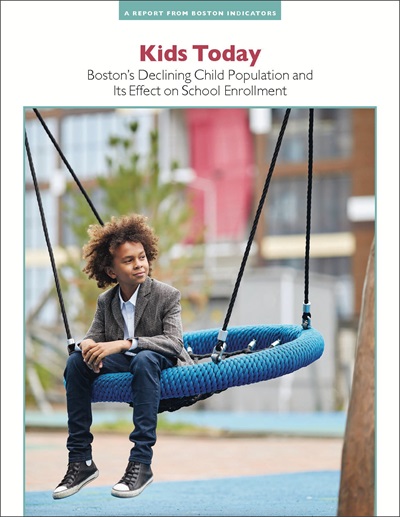Boston losing families with children, with significant impact on neighborhoods and schools, says new report
January 22, 2020
Boston – Boston’s economic boom is bringing growth and diversity to the city across most demographics, but the number of families with school-aged children is failing to keep pace, finds a new analysis from Boston Indicators and the Boston Foundation’s Education to Career strategy team. The report, Kids Today: Boston’s Declining Population and Its Effect on School Enrollment, finds middle-class families with children are leaving the city in high numbers, leaving behind a city that couples higher-income households without children and lower-income families with children who make up an ever-larger percentage of Boston Public Schools and Boston charter schools families.
“While Boston’s overall population has consistently risen since 1980, and especially in the last 20 years, the relative decline in families with children has a significant impact on our communities, our schools and the character of our city,” said Paul S. Grogan, President and CEO of the Boston Foundation. “The demographics highlight what has almost become two separate cities within our city – one of higher-income, less diverse, childless households, and the other of lower-income, largely Black and Latino families in which the vast majority of the city’s children live. Both the City of Boston and Boston’s district and charter schools deserve credit for their efforts to protect affordable housing and meet the needs of a new generation of students, but we must all do more to keep Boston accessible for all residents now and into the future.”
The analysis found that from 1980 to 2017, Boston’s population grew by an estimated 130,000 residents, but like other cities and the nation as a whole, Boston has seen its school-aged population share fall sharply – down by nearly half since 1970. Of Boston’s approximately 46,000 net new households in the past 40 years, barely 1,000 are households with children. Equally notable, the number of middle-class households actually fell, while the number of low- and high-income households rose sharply.
A primary consideration in this trend is the cost of housing. Boston has made significant efforts to protect affordable housing stock for lower-income families, and today about 1-in-5 housing units city-wide is income-restricted. At the other end of the spectrum, while higher-income, childless households are able to afford market-rate housing, rising costs have priced many middle-income families out of the market.
Shifting School Demographics
The data also captures a sharp drop in middle- and high-income (and predominantly white) children that happens just as children become ready for school. Among high-income households, the number of 5-to-9 year-olds in the city is less than half the number of 0-to-4 year olds – and there is a smaller but still significant decline in middle-class children as well. As a result, while white children make up over a third of Boston’s population under age 5, they represent less than 1-in-5 children aged 5 to 17 in Boston. Boston’s higher education institutions and booming economy brings white adults flocking back to the city, making Boston a majority-white or near-majority white city across adult demographics.
The impact of the number of middle and upper class white families leaving the city is readily seen in the demographics of public schools in the city. Overall, Boston’s combined district and charter school enrollment has fallen only slightly since 2000, but has seen a significant demographic shift. Nearly half of Boston district and charter students were Black in 2000, and just over a quarter were Latino. Today, while Boston as a whole is roughly 44% White, 22% Black, 20% Latino and 9% Asian, Boston Public Schools and charter schools serve a student population that is 13% White, 42% Latino, 35% Black and 7% Asian. More than 60% of Boston district and charter schools serve student bodies where more than 9-in-10 students are students of color.
To see whether those students were distributed evenly throughout the system, rather than segregated by racial groups, the analysis also sought to explore how well individual schools represented the overall student population. The results are mixed. In 2019, just over half of Boston district and charter schools had a population of students of color within ten percentage points of the systems’ 87 percent rate.
Shifting the focus to Black and Latino students shifts the story. Only 38 of 139 district and charter schools in Boston had Black and Latino populations within ten percentage points of the overall 77% Black and Latino rate. At 39 Boston district and charter schools, Black students made up more than half of the student body. Latino students were a majority at 37 schools. Five schools were majority-White and one was majority-Asian. Roughly half (48%) of Boston’s Black students attend majority-Black schools, while 42% of Latino students attend majority-Latino schools.
The report also explored changes in the percentage of students in Boston district and charter schools who are defined as low-income. Just as Boston’s public schools have come to serve a disproportionately high percentage of students of color, they are also serving a higher percentage of students from low-income households. In 1995, about 61 percent of Boston students came from low-income families and about 1-in-5 schools had student populations that were more than 80 percent low-income. By 2014, 77 percent of Boston students qualified as low-income. Accordingly, 82 district and charter schools had student populations that were more than 80 percent low-income, and 64 percent of Boston district and charter school students attended such schools.
Where the kids aren’t: Neighborhood changes
Lastly, the research explored how the number of school-aged children has changed in neighborhoods throughout the city. Among the largest residential neighborhoods, South Boston (-20%), Mattapan (-21%) and Dorchester (-25%) all saw declines of 20 percent or more between 2000 and 2017. At the other end, only West Roxbury (+16%) gained school-aged children by more than 10% over the time period. Hyde Park (+6%), East Boston (+2%) and the South End (+5%) all saw slight gains.

